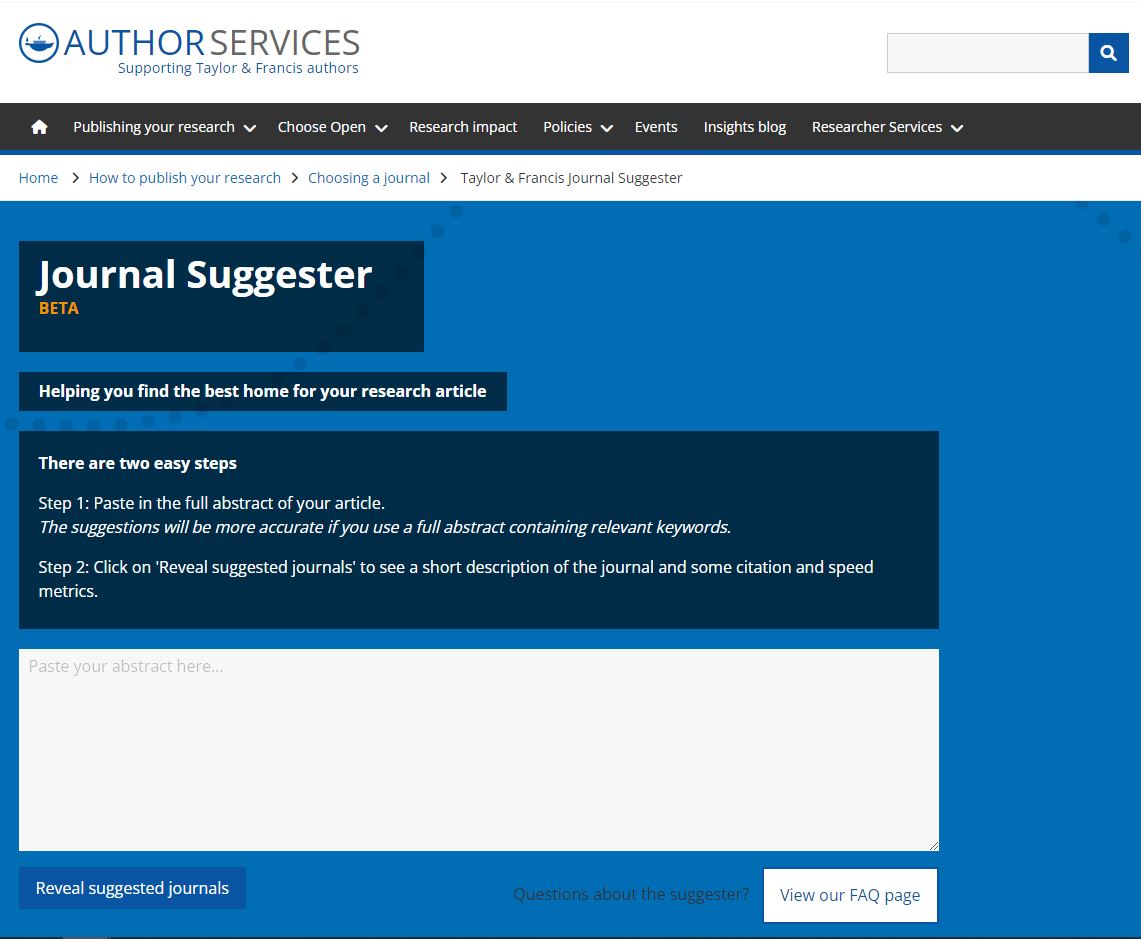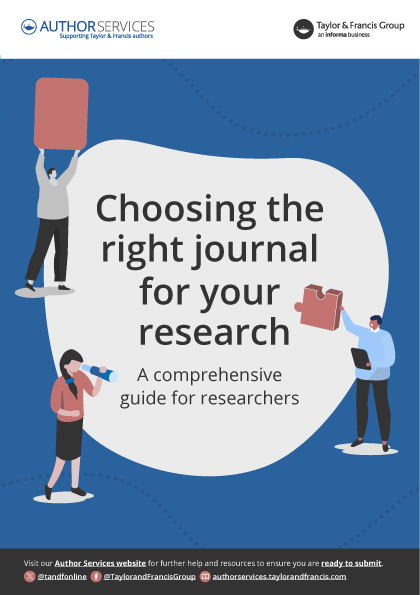3 great tools and resources to help you choose a journal
Narrow down your shortlist and identify the best home for your research
One of the most common reasons for manuscript rejection is submitting to an unsuitable journal.
Start your publication journey by choosing the right journal for your manuscript and you’ll improve your chances of acceptance and publication.

Having a preferred journal in mind will help you align your writing to meet the journal’s aims and scope. In this post we’ll introduce you to three tools and resources that will help you to find the right journal to publish in.
Choosing the right journal for your research: a comprehensive free guide
Our free guide for authors is packed full of information and tips to guide your through choosing a journal for your article.
You will learn a strategic approach to finding the right home for your work, as well as expert guidance on how to navigate the process.
Read the guide to find out all you need to know about:
Building a list of appropriate journals
Refining your options
How to know if a journal is trustworthy
You can only submit to one journal at a time so it’s important to get this right.
Download your free guide today to make sure you know how to choose a journal that’s the best fit for your article.
Post information
Related posts
The Taylor & Francis journal suggester tool
If you’ve already got a draft of your article abstract, the journal suggester is a great tool to help you find journals published by Taylor & Francis that might be a good fit.
The journal suggester uses artificial intelligence to review your abstract, compares it with published articles and pairs it with the most suitable journals. The tool will offer a shortlist of journal recommendations, including a brief description of the journal’s focus and a selection of key metrics.
Give it a try and you might discover some new options!

Choosing a journal checklist
After carrying out desk research, speaking to colleagues and using the journal suggester tool, you’ll probably have a shortlist of journals that could be a great fit for your research.
So, how can you narrow down your shortlist and make a final decision on where to submit?
Work through our 10-point checklist to make sure you’ve considered everything that could impact your chances of acceptance.
10 factors to consider while choosing the right journal for your research
What is your key message?
The purpose of your article will help you determine if it’s suitable for your target journal. Why did you write this article? To inform the reader? To prove a concept? To persuade the reader to do something?
Consider what the focus of your research is, and who you’d expect to read it and maybe even go on to cite it in their own work. This will build a picture of the type of journal you should be targeting.
The reference lists of similar articles to yours can also be a very useful resource. Take note of the journals that are regularly cited to identify which journals you should explore in more depth.Familiarize yourself with the journal’s content
Reading articles in your shortlisted journals is a good way to evaluate the quality of their publication. This will also help you recognize the kind of articles the journal publishes and the topics it covers. It’s a simple but very effective way of understanding whether your research is the right fit.
You can do this for Taylor & Francis journals by registering for an account at Taylor & Francis Online. Once you are set up, you will receive email notifications when new articles and issues are published in the journals you’ve selected.Check the journal’s aims and scope
The journal’s aims statement will inform you of the objective or purpose of the journal, while the scope explains how it will be achieved. If you understand what the journal is trying to accomplish, you can assess whether your article helps with that mission.
If you find that there are aspects of your research that don’t fit the scope of your target journals, it can be a sign that they may not be right for you. Try to tailor your article to the objectives of the journal that most closely suits your research and publication goals.
Find out more on how to use a journal’s aims and scope to find the right fit for your research.Understand the journal’s audience
What type of reader are you writing for? If the audience of your target journal is general-interest, then your article should be written in an easy-to-understand manner to reach a wide readership. More specialist audiences will be expecting greater detail and a deeper-dive into niche areas of the subject.
Ask yourself basic reader-centric questions. Is my work relevant to an international or regional audience? Will their readers find my work engaging? Will they learn something new? Will my article bring the readers back to that journal?Review the journal affiliation, editorial board and previous authors
These are a few factors that will help you understand the reach and prestige of a journal. Knowing a bit more about the journal’s community can help you decide if it’s the right place for you and your research.
Is the journal affiliated with a society or association that you are familiar with?
Are the editors and editorial board members well-respected in your field?
Have well-known researchers, academics, or practitioners published in the journal before?Get to know the journal policies and processes
Every journal has its own set of policies and procedures. These can cover how they conduct peer review, to their process for submitting your article.
As part of your publication plan, you may know which type of peer review you’d prefer for your article. Anonymous review, double-anonymous review, open review, etc. If this is important to you then make sure it factors into your decision. Take a look at our peer review resources to get an idea of what options you will need to choose from.
Learn more about Taylor & Francis editorial policies that apply across the whole portfolio of Taylor & Francis Journals.Check which article formats are accepted
This is why choosing a target journal before you write your article is important. You need to have guidance on the article format the journal accepts, word counts, or other limitations.
The format of the articles accepted by a journal is usually specified in the journal’s aims and scope statement.Understand your publishing options
Consider how you want to publish your research. Do you want it to be available to journal subscribers only? Or do you want it to be open access – freely and permanently available online, where anyone can read and build upon your work?
To help you decide whether open access is the right choice for your research, take a look at our guide on publishing open access.
These are factors you need to have answered when choosing the right journal to fit your work.Find out about journal metrics and discoverability
Journal metrics are an important factor to consider in your decision-making. Note that each metric has its limitations, so should never be considered in isolation.
Alongside how the journal measures up, you might also want to find out how discoverable it is. In other words, how easy it will be for your fellow researchers to find your article.
Here is more information on how to use data to choose a journal for submission.Which journal best meets your requirements?
It’s time to weigh your publication goals against the answers to the factors above.
Always think about the bigger picture. There is a journal out there for your work.
Researcher’s view
“It is important to know the journal requirements before one submits an article to a chosen journal. Quite often articles can be rejected not because they are not good enough, but because they do not fit the agenda of that journal…”
Grasian Mkodzongi, Ruth First Prize Winner

Download the choosing a journal free guide
The top-tier journals in your field may be the first that comes to mind for your submission. However, do these journals fit your publication goals or the content of your article?
Download your step-by-step comprehensive guide and find out all you need to know to make the right decision.
Where to next?
If you’ve found these tips helpful make sure you look at:
Our Insights newsletter – the latest news, tips, and resources delivered straight to your inbox.